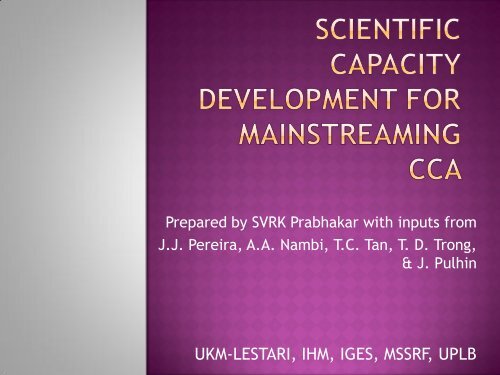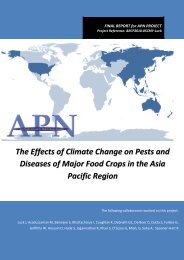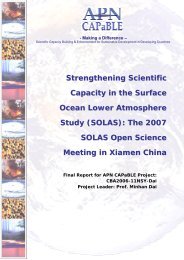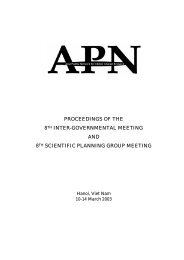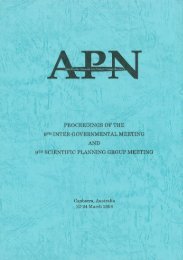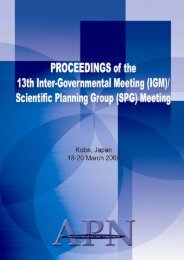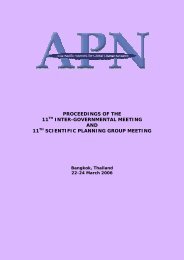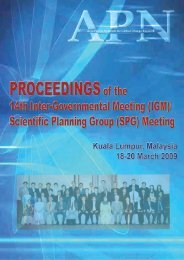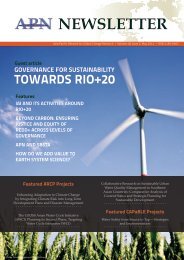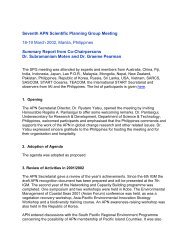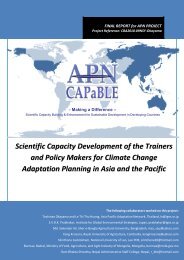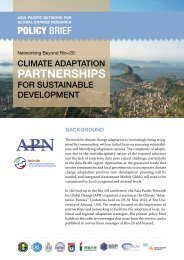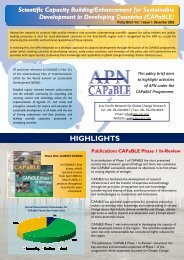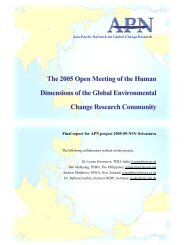Presentation - Asia-Pacific Network for Global Change Research
Presentation - Asia-Pacific Network for Global Change Research
Presentation - Asia-Pacific Network for Global Change Research
Create successful ePaper yourself
Turn your PDF publications into a flip-book with our unique Google optimized e-Paper software.
Prepared by SVRK Prabhakar with inputs from<br />
J.J. Pereira, A.A. Nambi, T.C. Tan, T. D. Trong,<br />
& J. Pulhin<br />
UKM-LESTARI, IHM, IGES, MSSRF, UPLB
� Short Title: Policy <strong>Research</strong> on Mainstreaming<br />
Adaptation to Climate <strong>Change</strong><br />
� 3yr project led by UKM-LESTARI (Malaysia) with<br />
� ‘Inside’ partners: IHM (Vietnam), MSSRF (India) and IGES<br />
(Japan)<br />
� ‘Outside partners’: IEDM-KU, UPLB<br />
� Components: identifying barriers to mainstreaming<br />
adaptation, measuring progress in mainstreaming,<br />
adaptive policies, and creating network of policy<br />
research institutions ARPNAP.
Country Barriers<br />
Scientific<br />
In<strong>for</strong>mation<br />
Institutions Scientific<br />
Capacity<br />
Financing Awareness DS Tools<br />
(incl.<br />
Metrics)<br />
India Local level Fragmentation Inadequate Local<br />
level<br />
Japan Mitigation<br />
priority<br />
Malaysia Local level<br />
Inadequate<br />
Philippines Local level Local capacity Inadequate Inadequate Local<br />
level<br />
Vietnam Local level Inadequate Inadequate Local<br />
level<br />
Non-existent<br />
Inadequate Non-existent<br />
Inadequate Non-existent<br />
Based on questionnaire surveys, expert consultations and focused group<br />
discussions with local communities<br />
Non-existent<br />
Non-existent
Generic criteria emerging<br />
from all study countries<br />
(not in any order)<br />
• Scalable<br />
• Simple (Easy to adopt)<br />
• Cost-effective/Costefficient<br />
• Policy and institutional<br />
compatibility<br />
• Robust (effective in<br />
diverse climate<br />
scenarios)<br />
• Clearly addresses<br />
adaptation concerns<br />
(provides clear<br />
adaptation benefits)<br />
• Easy to monitor<br />
E.g.: Criteria <strong>for</strong> prioritizing policies and practices in India
Food and agriculture self sufficiency policies introduced in Japan since 1940s<br />
Period Major Issues Major Policies<br />
Reconstruction period<br />
(1940s-60s)<br />
Post-Agricultural basic act<br />
period<br />
(1960s-70s)<br />
Low economic growth period<br />
(1970s-80s)<br />
<strong>Global</strong>ization period<br />
(1980s-90s)<br />
Structural re<strong>for</strong>ms period<br />
(1990s-2000)<br />
Realignment of agriculture<br />
(2000 onwards)<br />
Labor flow, farm land, restoration of<br />
farming, declining farming population<br />
Labor flow, farming popoulation decline,<br />
environmental quality, income disparity<br />
Labor flow, farming popoulation decline,<br />
environmental quality, income disparity<br />
Labor flow, farming popoulation decline,<br />
environmental quality, income disparity<br />
Farming population decline, farm land<br />
use change, aging of farming population<br />
Farmland use change, rice excess<br />
production, decline in farming<br />
population, decline in farm land use,<br />
crop losses due to heat etc.<br />
Staple food control act, Agricultural<br />
cooperatives act, Agricultural land act,<br />
Act on agricultural mechanization<br />
Agricultural basic-act, free trade,<br />
establishment of agricultural<br />
cooperatives<br />
Land use planning act, reconstruction of<br />
paddy fields, national rice cultivators<br />
committee<br />
Approval <strong>for</strong> GATT, free trade, new<br />
agricultural policy<br />
MAFF Env. Sound agriculture<br />
headquarters, staple food control act,<br />
new rice policy<br />
Restriction of GMOs by local<br />
governments, income compensation<br />
scheme <strong>for</strong> rice farmers<br />
Source: Multiple sources
Policy/Act No. of Time Period Avg. changes<br />
Amendments<br />
per year<br />
Agriculture cooperatives act 83 1948-2010 1.3<br />
Agricultural land act 66 1953-2010 1.2<br />
Food, agriculture and rural areas basic act 10 2000-2010 1<br />
Land improvement act 55 1951-2011 0.9<br />
Act on promotion of improvement of agricultural 19 1989-2010<br />
management infrastructure<br />
0.9<br />
Act on stabilization of supply, demand and prices 9 2000-2010<br />
of staple food<br />
0.9<br />
Act on special measures <strong>for</strong> promotion of<br />
9 2000-2011<br />
independence <strong>for</strong> underpopulated areas<br />
0.8<br />
Act on special measures concerning incentive loan 11 1995-2010<br />
program <strong>for</strong> youths to become farmers<br />
0.7<br />
Staple food control act 27 1943-1994 0.5<br />
Act on promoting the introduction of sustainable 3 2002-2010<br />
agricultural production practices<br />
0.4<br />
Agricultural improvement promotion act 16 1950-2004 0.3<br />
Act on promotion of agricultural mechanization 13 1962-2006 0.3<br />
Act on subsidies <strong>for</strong> agricultural improvement 16 1961-2010 0.3<br />
Agricultural policy 3 1978-1999 0.1<br />
Policy <strong>for</strong> delivering subsidies to the farmers <strong>for</strong> 1 2009<br />
stabilization of agriculture<br />
0<br />
Source: Compiled from multiple sources
(Data source: MAFF, 2011a)
(Data source: MAFF, 2011b)<br />
NOTE: Land usage change includes abandoning of cultivated land and farming land used<br />
<strong>for</strong> other industrial means
�Answer if it is an adaptation issue,<br />
�Achieve consensus within government and<br />
institutions responsible <strong>for</strong> their <strong>for</strong>mulation<br />
and implementation,<br />
�Prioritize ‘effectiveness’ over ‘urgency to show<br />
response’<br />
�Ensure feedback connections between policies<br />
and institutions, and<br />
�Expect things to change as policies are to<br />
operate in a dynamic environment.
� Means to reach and address issues at the local<br />
level are still at nascent stages and there is a<br />
need to strengthen the channels that connect<br />
various stakeholders to local level.<br />
� Channel resources <strong>for</strong> direct capacity<br />
development at local level.<br />
� Emphasize translating scientific in<strong>for</strong>mation into<br />
points that aid in daily decision making.<br />
� Greater need <strong>for</strong> developing decision support<br />
tools <strong>for</strong> ex-ante and ex-post decision making.<br />
� Promote horizontal and vertical institutional<br />
collaboration
Contact <strong>for</strong> more details: joy@ukm.my


